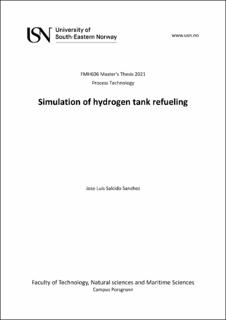| dc.description.abstract | Several simulations of hydrogen filling process for a type IV tank were completed using
openFOAM Computational Fluid Dynamics (CFD) open-source code. CFD codes have been
proven to be a useful method for estimating temperature and pressure distribution developed
inside the tank during refueling operations. All simulations were completed in a 2-D mesh and
for a simulated time of 20 seconds with varying initial tank pressures and mass flow rate at the
inlet. The transient, compressible and heat transfer rhoCentralFoam solver was used along with
the k-ω SST turbulence model to reproduce the effects of compressibility of the gas during the
filling.
The simulation cases were designated into two groups for comparing a 10 to 50 g/s mass flow
rate, along with different initial tank pressures of 1, 5, 10, 20, 30 and 35 MPa. The gas inlet
temperature was 273.15 K, with an initial tank and walls temperature of 298.15 K. Surrounding
temperature was selected as 298.15 K with a constant convective transfer coefficient of 10 W/m2
K. The simulated wall thickness is 5 mm with a thermal conductivity of 0.4 W/m K for
simulating a polymer liner.
Results for the temperature and pressure distribution within the tank are in agreement with
previous research papers’ findings for which larger initial pressures lead to minor increments in
temperature during refueling. Larger initial pressures resulted in less gas velocities at the inlet.
Temperature rise is heavily dependent of the inlet gas mass flow, as a higher flow will result in
more mass dispensed into the tank. The applicability of these findings suggests that at the start of
the gas refueling process, a low mass flow rate can be dispensed, as the instant change in
temperature is smaller, and once a higher pressure is developed within the tank, increase the
mass flow to achieve a faster fill.
The convective heat transfer coefficient is influenced by the mass flow rate. For lower initial
pressure simulations, higher values are achieved at the end region of the tank, far away from the
inlet, due to gas compression. In some instances, negative coefficient values were developed, as
tank wall temperature went lower than initial temperature condition, leading to a negative heat
flux into the tank.
Higher initial pressure cases resulted in oscillations of the variables through the simulation.
Finer mesh analysis is suggested to verify mesh dependency. | |
